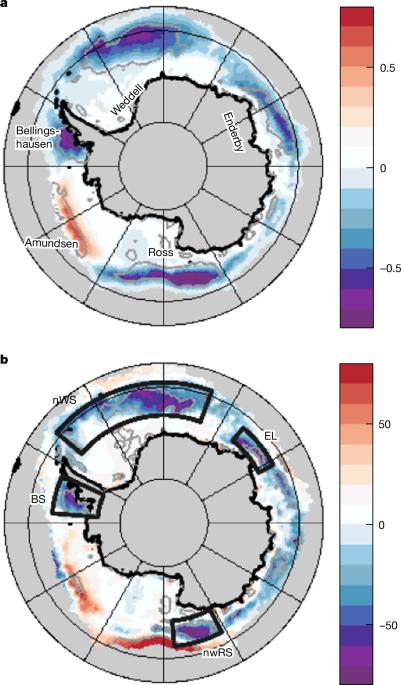2023年创纪录的南极海冰增加了海洋热量损失和风暴
IF 48.5
1区 综合性期刊
Q1 MULTIDISCIPLINARY SCIENCES
引用次数: 0
摘要
最近南极海冰的减少是一个令人担忧的重大问题,特别是2023年的创纪录低点(参考文献1)。在确定冰损失的原因方面已取得进展1 - 5,但其对海洋-大气相互作用的影响仍不确定。解决这种不确定性是很重要的,因为冰的减少会大大改变表面的热损失,从而改变海洋和大气。本文表明,2023年冬季最强的冰退缩区为冬季大气湍流海洋热损失提供了一个重要的新来源。这些地区(主要位于威德尔海、别令斯豪森海和罗斯海)的冰浓度减少了80%,并伴随着冬季中期海洋热量损失的前所未有的加倍。4月下旬至6月中旬的热损失高峰时间也存在相移现象,其中南部秋季的热损失弱于正常。冬季表面热损失的加剧伴随着海洋-大气界面两侧的实质性变化。这包括大气风暴频率的增加和地表热损失驱动的致密水形成,尽管致密化对更广泛的过程(如南极底水形成)的影响尚不清楚。我们的研究结果表明,2023年南极海冰的减少大大改变了南大洋的海气相互作用,并激发了对更广泛的气候系统影响的深入分析。2023年创纪录的南极海冰减少大大改变了南部海洋与大气的相互作用,导致前所未有的冬季湍流海洋热量流失到大气中,增加了风暴和密集水的形成。本文章由计算机程序翻译,如有差异,请以英文原文为准。

Record-low Antarctic sea ice in 2023 increased ocean heat loss and storms
Recent Antarctic sea-ice decline is a substantial source of concern, notably the record low in 2023 (ref. 1). Progress has been made towards establishing the causes of ice loss1–5 but uncertainty remains about its consequences for ocean–atmosphere interaction. Resolution of this uncertainty is important as ice decline can substantially alter surface heat loss and thus the ocean and atmosphere6. Here we show that the strongest winter 2023 ice-retraction regions provide an important new source of turbulent ocean heat loss to the atmosphere in wintertime. Ice concentration in these regions (located primarily in the Weddell, Bellingshausen and Ross seas) is reduced by up to 80% and is accompanied by an unprecedented doubling of mid-winter ocean heat loss. Also, there is a phase shift in the time of peak heat loss from late April to mid-June, with weaker than normal heat loss in austral autumn. The winter surface-heat-loss intensification is accompanied by substantial changes on both sides of the ocean–atmosphere interface. These include increases in atmospheric-storm frequency and surface-heat-loss-driven dense water formation, although the implications of the densification for broader processes such as Antarctic bottom water formation remain unclear. Our results reveal that the 2023 Antarctic sea-ice loss has substantially modified air–sea interaction in the Southern Ocean and motivate in-depth analysis of the wider climate-system impacts. The record-low Antarctic sea-ice decline in 2023 substantially altered Southern Ocean–atmosphere interaction leading to unprecedented wintertime turbulent ocean heat loss to the atmosphere, enhanced storminess and increased dense water formation.
求助全文
通过发布文献求助,成功后即可免费获取论文全文。
去求助
来源期刊

Nature
综合性期刊-综合性期刊
CiteScore
90.00
自引率
1.20%
发文量
3652
审稿时长
3 months
期刊介绍:
Nature is a prestigious international journal that publishes peer-reviewed research in various scientific and technological fields. The selection of articles is based on criteria such as originality, importance, interdisciplinary relevance, timeliness, accessibility, elegance, and surprising conclusions. In addition to showcasing significant scientific advances, Nature delivers rapid, authoritative, insightful news, and interpretation of current and upcoming trends impacting science, scientists, and the broader public. The journal serves a dual purpose: firstly, to promptly share noteworthy scientific advances and foster discussions among scientists, and secondly, to ensure the swift dissemination of scientific results globally, emphasizing their significance for knowledge, culture, and daily life.
 求助内容:
求助内容: 应助结果提醒方式:
应助结果提醒方式:


